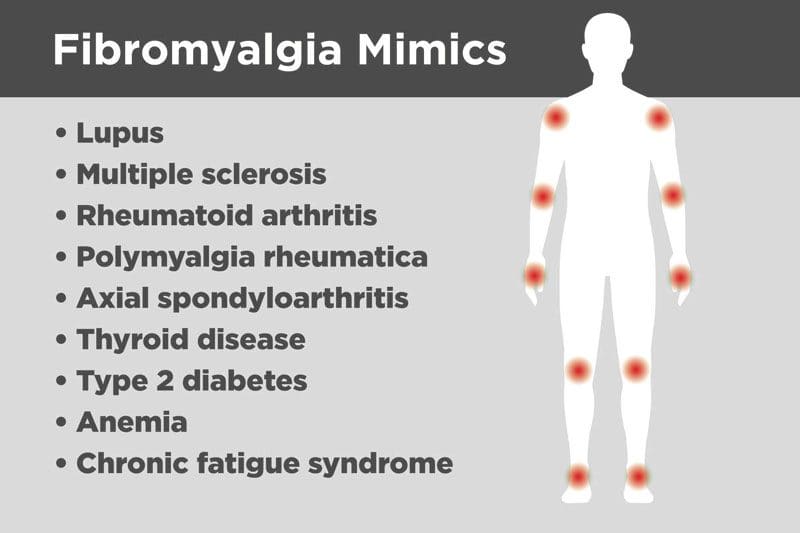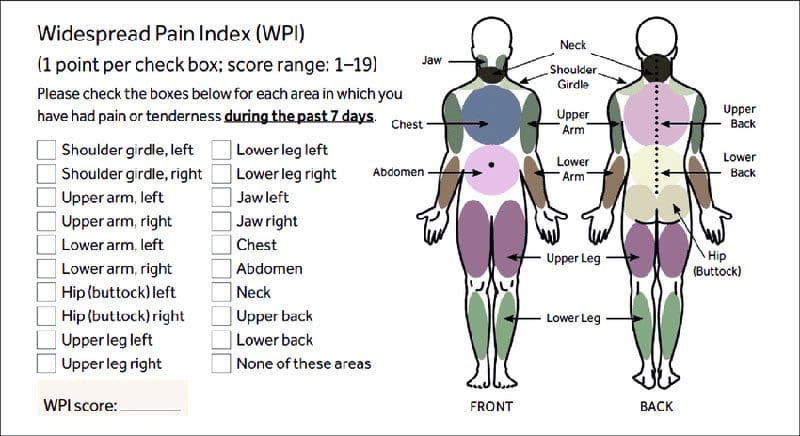- Rheumatoid arthritis
- Chronic fatigue syndrome
- Lupus

Table of Contents
Fibromyalgia Diagnosis Criteria
- Pain and symptoms based on the total number of painful areas
- Fatigue
- Poor sleep
- Thinking problems
- Memory problems

Diagnostic Process
Medical History
A doctor will look at an individual’s complete medical history, asking about any other conditions present and family condition/disease history.Symptoms Discussion
The most common questions asked by a doctor are where it hurts, how it hurts, how long it hurts, etc. However, an individual should offer as much or added details of their symptoms. Diagnosing fibromyalgia is very dependent on the report of the symptoms, so it is important to be as specific and accurate as possible. A pain diary, which is a record of all symptoms that present will make it easier to remember and share information with the doctor. An example is giving information on trouble sleeping, with a feeling of tiredness a majority of the time, and headache presentation.Physical Examination
A doctor will palpate or apply light pressure with the hands around the tender points.
Other Tests
As previously stated symptoms can be very similar to other conditions like:- Rheumatoid arthritis
- Hypothyroidism
- Ankylosing spondylitis
Anti-nuclear antibody – ANA test
Anti-nuclear antibodies are abnormal proteins that can present in the blood if an individual has lupus. The doctor will want to see if the blood has these proteins to rule out lupus.Blood count
By looking at an individual’s blood count, a doctor will be able to develop other possible causes for extreme fatigue like anemia.Erythrocyte sedimentation rate – ESR
An erythrocyte sedimentation rate test measures how quickly red blood cells fall to the bottom of a test tube. In individuals with a rheumatic disease like rheumatoid arthritis, the sedimentation rate is higher. The red blood cells fall quickly to the bottom. This suggests that there is inflammation in the body.
Rheumatoid factor – RF test
For individuals with an inflammatory condition like rheumatoid arthritis, a higher level of the rheumatoid factor can be identified in the blood. A higher level of RF does not guarantee that the pain is caused by rheumatoid arthritis, but doing an RF test will help the doctor explore a possible RA diagnosis.Thyroid tests
Thyroid tests will help a doctor rule out thyroid problems.Final Note Fibromyalgia Diagnosis
Again, diagnosing fibromyalgia can take awhile. A patient’s job is to be proactive in the diagnostic process. Be sure you understand what the results will tell and how that specific test will help figure out the cause of the pain. If you don’t understand the results, keep asking questions until it makes sense.InBody
Body composition and Diabetes Connection
The body needs a balance of lean body mass and fat mass to function properly/optimally and maintain overall health. The balance can be disrupted in overweight and obese individuals because of excess fat. Individuals that are overweight should focus on improving body composition by reducing fat mass while maintaining or increasing lean body mass. Balanced body composition can reduce the risk of diabetes, other obesity-related disorders, and a positive effect on metabolism. Metabolism is the breaking down of foods for energy, the maintenance, and repair of body structures. The body breaks down the food nutrients/minerals into elemental components and directs them to where they need to go. Diabetes is a metabolic disorder meaning it changes the way the body makes use of the nutrients, in such a way that the cells are unable to utilize digested glucose for energy. Without insulin, the glucose cannot get into the cells, so it ends up lingering in the blood. When the glucose can’t make its way out of the blood, it builds up. All the excess blood sugar can potentially be converted to triglycerides and stored as fat. With an increase in fat mass, hormone imbalances or systemic inflammation can happen or progress. This increases the risk for other diseases or conditions. A buildup of fat and diabetes are associated with increased risk for:- Heart attacks
- Nerve damage
- Eye problems
- Kidney disease
- Skin infections
- Stroke
Dr. Alex Jimenez’s Blog Post Disclaimer
The scope of our information is limited to chiropractic, musculoskeletal, physical medicines, wellness, and sensitive health issues and/or functional medicine articles, topics, and discussions. We use functional health & wellness protocols to treat and support care for injuries or disorders of the musculoskeletal system. Our posts, topics, subjects, and insights cover clinical matters, issues, and topics that relate and support directly or indirectly our clinical scope of practice.* Our office has made a reasonable attempt to provide supportive citations and has identified the relevant research study or studies supporting our posts. We also make copies of supporting research studies available to the board and or the public upon request. We understand that we cover matters that require an additional explanation as to how it may assist in a particular care plan or treatment protocol; therefore, to further discuss the subject matter above, please feel free to ask Dr. Alex Jimenez or contact us at 915-850-0900. The provider(s) Licensed in Texas& New Mexico*References
American College of Rheumatology. Fibromyalgia. 2013. http://www.rheumatology.org/Practice/Clinical/Patients/Diseases_And_Conditions/Fibromyalgia/. Accessed December 5, 2014. Living with Fibromyalgia: Mayo Clinic Proceedings. (June 2006) “Improvement in Fibromyalgia Symptoms With Acupuncture: Results of a Randomized Controlled Trial” www.sciencedirect.com/science/article/abs/pii/S0025619611617291 What Are Common Fibromyalgia Symptoms and How Does It Cause Back Pain?: Clinical Biomechanics. (July 2012) “Functional capacity, muscle strength and falls in women with fibromyalgia” www.sciencedirect.com/science/article/abs/pii/S0268003311003226Post Disclaimer
Professional Scope of Practice *
The information herein on "Chiropractic Examination Fibromyalgia Diagnosis" is not intended to replace a one-on-one relationship with a qualified health care professional or licensed physician and is not medical advice. We encourage you to make healthcare decisions based on your research and partnership with a qualified healthcare professional.
Blog Information & Scope Discussions
Welcome to El Paso's Wellness blog, where Dr. Alex Jimenez, DC, FNP-C, a board-certified Family Practice Nurse Practitioner (FNP-C) and Chiropractor (DC), presents insights on how our team is dedicated to holistic healing and personalized care. Our practice aligns with evidence-based treatment protocols inspired by integrative medicine principles, similar to those found on dralexjimenez.com, focusing on restoring health naturally for patients of all ages.
Our areas of chiropractic practice include Wellness & Nutrition, Chronic Pain, Personal Injury, Auto Accident Care, Work Injuries, Back Injury, Low Back Pain, Neck Pain, Migraine Headaches, Sports Injuries, Severe Sciatica, Scoliosis, Complex Herniated Discs, Fibromyalgia, Chronic Pain, Complex Injuries, Stress Management, Functional Medicine Treatments, and in-scope care protocols.
Our information scope is limited to chiropractic, musculoskeletal, physical medicine, wellness, contributing etiological viscerosomatic disturbances within clinical presentations, associated somato-visceral reflex clinical dynamics, subluxation complexes, sensitive health issues, and functional medicine articles, topics, and discussions.
We provide and present clinical collaboration with specialists from various disciplines. Each specialist is governed by their professional scope of practice and their jurisdiction of licensure. We use functional health & wellness protocols to treat and support care for the injuries or disorders of the musculoskeletal system.
Our videos, posts, topics, subjects, and insights cover clinical matters, issues, and topics that relate to and directly or indirectly support our clinical scope of practice.*
Our office has reasonably attempted to provide supportive citations and has identified the relevant research studies or studies supporting our posts. We provide copies of supporting research studies available to regulatory boards and the public upon request.
We understand that we cover matters that require an additional explanation of how they may assist in a particular care plan or treatment protocol; therefore, to discuss the subject matter above further, please feel free to ask Dr. Alex Jimenez, DC, APRN, FNP-BC, or contact us at 915-850-0900.
We are here to help you and your family.
Blessings
Dr. Alex Jimenez DC, MSACP, APRN, FNP-BC*, CCST, IFMCP, CFMP, ATN
email: coach@elpasofunctionalmedicine.com
Licensed as a Doctor of Chiropractic (DC) in Texas & New Mexico*
Texas DC License # TX5807
New Mexico DC License # NM-DC2182
Licensed as a Registered Nurse (RN*) in Texas & Multistate
Texas RN License # 1191402
ANCC FNP-BC: Board Certified Nurse Practitioner*
Compact Status: Multi-State License: Authorized to Practice in 40 States*
Graduate with Honors: ICHS: MSN-FNP (Family Nurse Practitioner Program)
Degree Granted. Master's in Family Practice MSN Diploma (Cum Laude)
Dr. Alex Jimenez, DC, APRN, FNP-BC*, CFMP, IFMCP, ATN, CCST
My Digital Business Card


